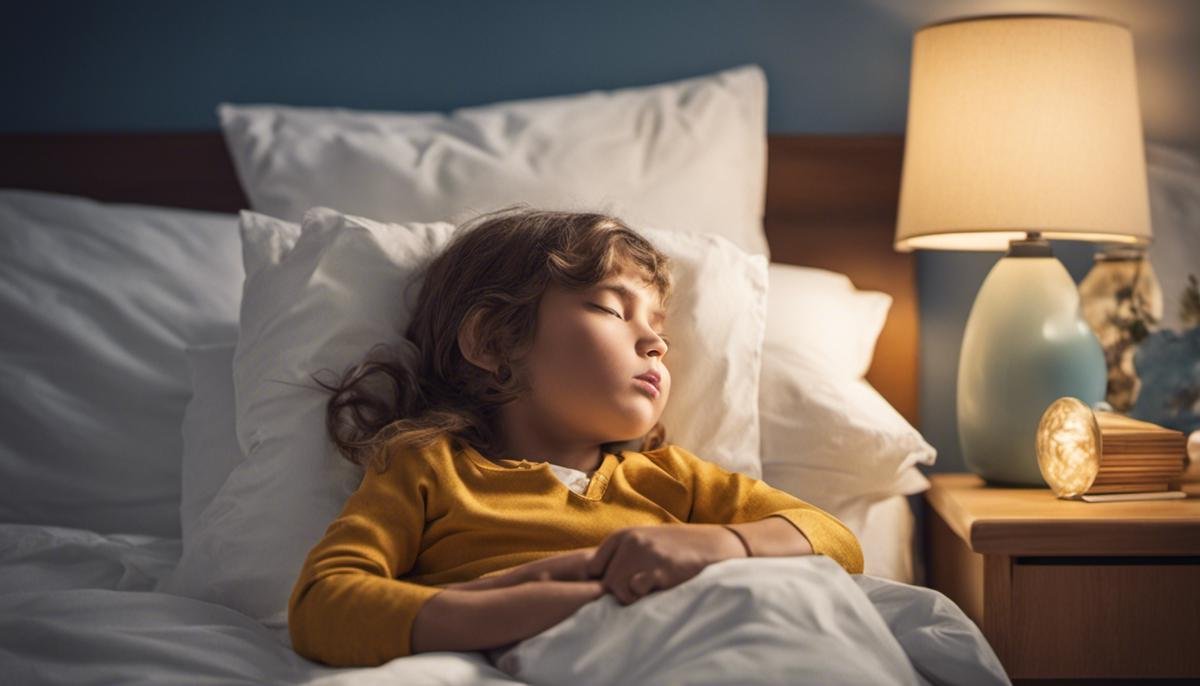
Autism Spectrum Disorder (ASD) encompasses a variety of conditions characterized by challenges with social skills, repetitive behaviors, speech, and nonverbal communication. Often, it brings along unique sleep challenges that can significantly impact the lives and developmental growth of children with autism. Understanding the nature of autism and its relation to sleep-related issues, appreciating the importance of high-quality sleep for these children, and learning practical methods for implementing healthy sleep habits are all essential for their well-being. This insightful exposition provides an overview of autism-related sleep disruptions and shines light on the diverse sleep training methodologies, as well as offers valuable coping strategies for parents undertaking the journey of managing their child’s sleep patterns effectively.
Understanding Autism and Sleep
Title: Unraveling the Connection: Autism and Sleep in Children
Ever wonder why your little one with autism spectrum disorder (ASD) has trouble drifting off to dreamland? Many parents in the same boat are puzzled about the sleep issues prevalent among children with autism. Just like every snowflake is unique, so too are the reasons and manifestation of sleep difficulties in children with ASD. Luckily, understanding the connection between autism and sleep can unveil solutions and strategies that can help.
First things first – let’s delve into what exactly is happening. Research suggests that nearly 80% of children with autism endure some form of sleep disruption. From having trouble falling asleep, staying asleep, or experiencing erratic sleep patterns, these nighttime hurdles can be challenging for both the child and the whole family.
What’s behind this? Autism’s impact on sleep can be traced to several factors. Firstly, children with ASD often exhibit increased levels of anxiety and hyperactivity, which can inherently make it more difficult to relax and drift off to sleep. Additionally, many children with autism tend to struggle with sensory processing, which means everyday sounds, lights, and even the texture of pajamas or bed sheets can disrupt their ability to fall asleep or stay asleep.
Moreover, many autistic children produce lower levels of melatonin, the hormone that regulates sleep. This factor, combined with dietary issues commonly associated with autism, such as gastrointestinal troubles or food sensitivities, can greatly impact sleep quality.
The challenges don’t stop at bedtime; the effects ripple into the daylight hours. Restless nights can lead to daytime fatigue, difficulty concentrating, and increased behavioral issues, like irritability or hyperactivity.
Now that this connection is better understood, you’re probably considering possible solutions. Thankfully, there are viable strategies for improving sleep in children with autism. They range from creating a calm and serene sleep environment to establishing a consistent bedtime routine, turning the screens off well before bedtime, and, in some cases, supplementing with melatonin under the guidance of a healthcare practitioner.
Behavioral interventions can also prove effective, such as cognitive-behavioral therapy, relaxation techniques, and guided imagery. Engage a professional such as a child psychiatrist or behavioral therapist to explore these options.
In cases where dietary issues may be contributing, seeking the advice of a nutritionist or dietitian experienced in managing autism can be beneficial. They can help identify any food sensitivities and recommend a balanced diet that supports overall well-being, including sleep quality.
Journeying through parenting a child with autism isn’t always straightforward, but with love, understanding, and the right information, hurdles can be transformed into stepping-stones. Remember, every child is unique, and patience is a virtue as you navigate the course. It may take some trial and error to find the right approach, but a good night’s sleep for your little one – and indeed, for the whole household – is a reward worth striving for. So let’s tuck in to a future filled with peaceful, restorative nights.

The Importance of Sleep for Autistic Kids
Unveiling the Importance of Sleep For Children With Autism
Recognizing the pivotal role of sleep in children with Autism Spectrum Disorder (ASD) imparts insight into how to nurture their development. In this write-up, we dig deeper into this crucial aspect of child development and unearth its sheer importance.
Of paramount concern when discussing sleep disruption in children with ASD is viewing it not only as an isolated issue. It’s indeed engrained within a broader perspective- the wholesome well-being of a child. Thereby, understanding why it’s vital for your autistic child to have a healthy sleep routine can filter through to other areas of their life, furnishing them with more concretized guidance and support.
Overarching the aforementioned points, it’s undeniable that sleep disruption traits in children with ASD are linked to various daytime maladies. These can include but are not limited to behavioral issues, emotional distress, and cognitive impairment. This further underscores the importance of sound sleep for these children, driving home the point that sleep isn’t a mere luxury but an absolute necessity for them.
On the topic of sleep strategies for children with autism, it’s worthwhile to note that insight into the mechanism behind these strategies gives parents the ammunition to tackle sleep disruptions head-on. This knowledge, coupled with a loving attitude borne from understanding, means parents can create a sleep-enhancing environment that’s both tailored to their child’s needs and adjusts accordingly with changes over time.
Playing a significant role in this arena are behavioral interventions, like cognitive-behavioral therapy and relaxation techniques. Their efficacy in improving sleep in children with ASD could be revolutionizing. They provide the salient tools to maneuver towards a gentle progression of better sleep patterns, helping children with ASD flourish in their development.
Equally important to remember is that in this quest for better sleep, nutrition holds a vital key in the ASD puzzle. Stemming from this realization, there exists the importance of professional aid in the likes of a nutritionist or dietician. These experts can not only guide but also support in deciphering the complex relationship between diet and autism with respect to sleep.
The culmination of this understanding can be distilled into a rather simple truth: each child with autism is unique, with their own sets of strengths and difficulties that require individual understanding and patience. So while it’s true that sleep plays a pivotal role in their overall development and well-being, it’s equally important to understand and appreciate their uniqueness. Allow them to grow at their pace and you will be amazed at their resilience and potential. The journey of improving sleep in children with ASD is no easy task, but with patience and understanding, it’s certainly achievable and utterly rewarding.

Photo by priscilladupreez on Unsplash
Sleep Hygiene for Autistic Kids
So, let’s dive further into additional strategies that can help aid peaceful sleep for children with Autism Spectrum Disorder (ASD). Having covered vital factors such as the role of anxiety, hyperactivity and melatonin, the influence of dietary issues, and the value of patience and understanding, we now turn our attention to some more powerful tools in our sleep-hygiene toolkit.
Evolving around a stable sleep schedule is a crucial sleep hygiene practice for every child, not just for those with autism. However, this practice becomes all the more significant for children with ASD, who typically fare better with consistent routines. Sticking to sleep and wake-up times every single day, yes, even on weekends and holidays, helps regulate the child’s internal body clock and can aid in falling asleep and waking up more easily.
In conjunction with a stable sleep schedule, practice ‘quiet time’ before bed. Much like the bedtime routine touched upon earlier, dedicate time for calming activities such as reading or listening to soft music. It’s best to eliminate activities that can potentially overstimulate, like playing with electronic devices.
Weighted blankets are another helpful tool when dealing with sleep disruptions in children with autism. Weighted blankets provide deep pressure stimulation that has a calming effect on the body, lowering anxiety and leading to better quality sleep. Just always ensure that the weighted blanket is no more than 10% of the user’s body weight and that the child can easily move it on their own.
To tackle the sensory processing issues that many children with autism may face during bedtime, considering a sensory sleep environment could be invaluable. Freeing the bedroom of distracting sounds, lights, and odors whilst opting for soft, comfortable bedding can lead to a tranquil, sensory-friendly bedroom environment.
Moreover, physical exercise is yet another method to induce better sleep. Regular exercise, preferably outdoors where the child can soak up some natural daylight, is known to improve the quality and length of sleep.
Finally, do not hesitate to reach out to pediatric sleep specialists. These professionals can provide customized plans and guidance that suit your child’s specific needs and challenges – remember, each child with autism is indeed unique and thus may require a personalized approach.
Applying these sleep hygiene practices might not provide an instant cure for sleep problems, but they are definitely steps in the right direction. Ultimately, improving sleep health can significantly contribute to enhancing the overall well-being of a child with autism. Let’s embark on this journey with a heart full of patience, understanding, and commitment – the rewards are most certainly worth it.

Photo by amytreasure on Unsplash
Behavioral Sleep Training Techniques
Moving forward in our exploration of effective behavioral sleep training techniques for children with autism, it’s time to discuss some focused strategies. These are brief but helpful tools for parents navigating the often challenging, but ultimately rewarding journey of fostering better sleep habits in their child with Autism Spectrum Disorder (ASD).
Firstly, the value of a stable sleep schedule cannot be overstated. Children with ASD often thrive on routines, with predictability reducing anxiety and creating a sense of security. Try adhering to consistent bedtime and wakeup hours, even on weekends and vacations. This consistency trains the child’s internal clock, reducing sleep conflicts and potentially improving the overall quality of rest.
Another strategy that comes highly recommended is implementing ‘quiet time’ before bed. This period, perhaps 30 minutes to an hour, should be filled with calming activities – think reading a favorite book, soft music, or soothing audio stories. Limiting intense or stimulating activities during this transitional period can help your child unwind, signaling to their brain that it’s time to prepare for sleep.
Weighted blankets can also be particularly beneficial for children with ASD. They provide a calming, grounding effect, delivering deep touch pressure that stimulates serotonin production, which naturally incites relaxation. A weighted blanket can be a comforting tool in your child’s sleep environment, promoting quicker sleep onset and fewer nighttime awakenings. Of course, personal preference and safety should dictate the appropriate weight and size.
Speaking of the sleep environment, parents would do well to consider a sensory-friendly sleep space. This involves controlling stimuli like light, sound, and touch to make the environment more comfortable for your child’s specific needs. For instance, black-out curtains can restrict light intrusion while white noise machines can mask disruptive sounds.
Physical exercise is another proven technique to improve sleep quality. Regular physical activities can help regulate the body’s circadian rhythm, burn off excess energy, and support the production of sleep-promoting hormones. Just remember to conclude any vigorous activities several hours before bedtime to avoid overstimulation.
Should these methods not yield the awaited results, or if the sleep problems persist, parents shouldn’t hesitate to consult pediatric sleep specialists. These professionals can provide targeted interventions based on your child’s unique behavioral and physiological sleep issues, guiding the family to a solution that’s bespoke to your child’s needs.
Lastly, recognize that these practices will not transform your child’s sleep habits overnight. Gradual improvement is the name of the game here. Be patient, persistent, and forgiving of setbacks that may occur. Celebrate victories, no matter how small, and remember you’re armed with the right tools to make lasting changes for your child’s sleep health.
With understanding, patience, and the power of these techniques combined, parents can make great strides in improving their child with ASD’s slumber, turning sleep disruptions into restful nights and brighter days.

Medical Interventions for Sleep
Understanding the Role of Medical Interventions for Sleep Challenges in Children with Autism
Despite the range of sleep strategies and natural interventions available for children with Autism Spectrum Disorder (ASD), there can be instances where these measures may not suffice. In such cases, a higher level of intervention, predominantly in the form of medical treatments, becomes necessary. Recognizing when to escalate to these interventions and understanding what they involve is an integral part of the care journey for a child with ASD.
Uncontrolled sleep disruption, which significantly impacts the well-being and daytime behavior of a child, despite employing varied strategies, signals the necessity of medical interventions. Predominantly, medical professionals may consider prescription medications when a child with autism’s sleep problems significantly impair their daytime functioning and quality of life, and when non-pharmacologic interventions have not brought about the desired improvements.
One standard pharmacological intervention involves the use of prescribed medications. Usually, these encompass drugs such as alprazolam and other prescription sleep aids. Your child’s doctor might consider these if your child’s insomnia is severe and affecting their overall health. Nevertheless, it is crucial to remember that these medications are typically a last resort after other interventions have been explored and elicit notably fewer results than expected.
Another commonly used medical intervention involves the use of prescribed melatonin. Melatonin, a hormone that helps regulate the sleep/wake cycle, is often lower in children with ASD. For some children, where lifestyle adjustments and improved sleep hygiene aren’t sufficient, prescribed melatonin supplements might be considered. However, it is always critical to consult with a healthcare provider before starting melatonin, or any new medication or supplement.
While considering medical interventions, it is also important to remember the role of ongoing analysis. Monitoring the child’s sleep patterns, behavior, health, and response to medications forms an essential part of this process. Tools like sleep diaries and actigraphy can be extremely useful in this regard.
Furthering the intervention process, consultation with sleep specialists or even entailing the services of sleep clinics can provide invaluable assistance. Sleep clinics offer intensive resources, including overnight sleep studies that can assess a child’s sleep stages and cycles to identify disruptions in an objective and comprehensive manner. They can diagnose potential sleep disorders like sleep apnea, which can then be medically managed.
Transcranial magnetic stimulation (TMS) is another treatment currently being explored to assist children with ASD and sleep issues. While it’s still in the research phase, it is believed that TMS could stimulate certain areas of the brain to assist with sleep regulation. It underlines the ongoing developments within the field of ASD sleep interventions, continuing to provide hope and options for families.
Navigating the realms of medical treatment in search of a better night’s sleep for a child with autism can undoubtedly feel like a daunting journey, laden with both uncertainty and hope. The support and guidance from medical professionals, paired with a generous measure of patience and understanding, can indeed make all the difference in exploring these paths of intervention. It becomes vital to remember that each child is unique, their response to treatments will be personal, and every small improvement is a substantial victory.
Sleep is essential for every child and even more so for children with ASD. With continued research and advancements in the understanding and medical management of ASD, more comprehensive and effective interventions will no doubt continue to emerge. And through it all, families can find small, steady steps leading towards larger leaps of improvement, gradually painting a clearer, brighter picture on the horizon.

Coping Strategies for Parents
Advancing on from these foundational considerations, there are a few more coping strategies that parents can adopt for managing sleep problems in their child with Autism Spectrum Disorder (ASD).
The first revolves around medication use and intervention. Many parents question: ‘When is it vital to consider medical interventions?’ There is no concrete answer for this, as every child with autism is unique. It may become a consideration when sleep issues persist despite consistent behavioral strategies, or when problems are so severe that they significantly disrupt the child and family’s daily function and quality of life.
Prescription medications can sometimes be a viable treatment option, with the provision that any medication usage is under the careful watch of a medical professional. One common medication approach is the use of melatonin, a hormone that plays a key role in regulating the sleep-wake cycle. Studies have shown that melatonin can significantly improve sleep duration, quality, and latency in children with ASD.
Continual monitoring of sleep patterns is an essential part of improving the sleep situation. It’s recommended to maintain a detailed sleep diary, noting patterns of wakefulness, night terrors, or periods of restlessness. This can be invaluable when consulting with health professionals about your child’s sleep patterns.
It’s also crucial not to hesitate in drafting in expert help. Sleep specialists and pediatric sleep clinics can contribute to a comprehensive assessment and treatment plan. These professionals can provide invaluable insights and tailored strategies based on your child’s specific needs.
An intriguing development in the field is transcranial magnetic stimulation (TMS). While still a novel treatment, some research suggests it could have potential benefits for individuals with autism, including improved sleep.
The journey through medical interventions for better sleep can be daunting. However, it’s vital to remember that it’s just that – a journey. It’s all about finding what works best for your child and your family.
Remember, every child with autism is unique. It’s entirely okay if what works for one child doesn’t work for another. The key is persistence and patience, always striving to best meet your child’s sleep needs.
Importantly, celebrate the small improvements. Each positive step towards better sleep health, regardless of how small, is a victory in itself.
Finally, continued research and advancements offer hope for the future. More and more, science is learning about ASD, and fresh strategies and techniques are constantly evolving to help address the sleep challenges in children with ASD. As parents, it becomes our responsibility to stay updated and informed about these advancements.
So, in conclusion, while managing sleep in children with ASD can often feel like an uphill climb, with the right tools, techniques, and support, it becomes much more manageable. And the benefits of improved sleep for your child’s health, behavior, and overall quality of life makes the efforts well worth it.

Cultivating healthy sleep patterns in children with autism is a multi-faceted endeavor that requires deep comprehension, patience, and consistent effort. A fusion of behavioral techniques, proper sleep hygiene, and in some cases, medical interventions, can pave the way towards better sleep quality, thereby enhancing their developmental prospects and overall life quality. Parents are not alone in this journey, and should seek support when needed, valuing self-care while navigating this challenging path. Most importantly, adopting a positive perspective, even amidst challenges, can foster courage and resilience. Thus, fostering better sleep practices for children with autism is not merely a quest to mitigate nighttime struggles, but a pivotal part of securing their well-being and potential for growth.




